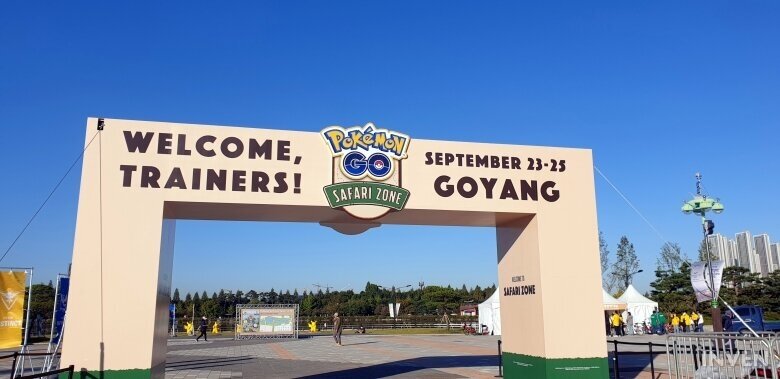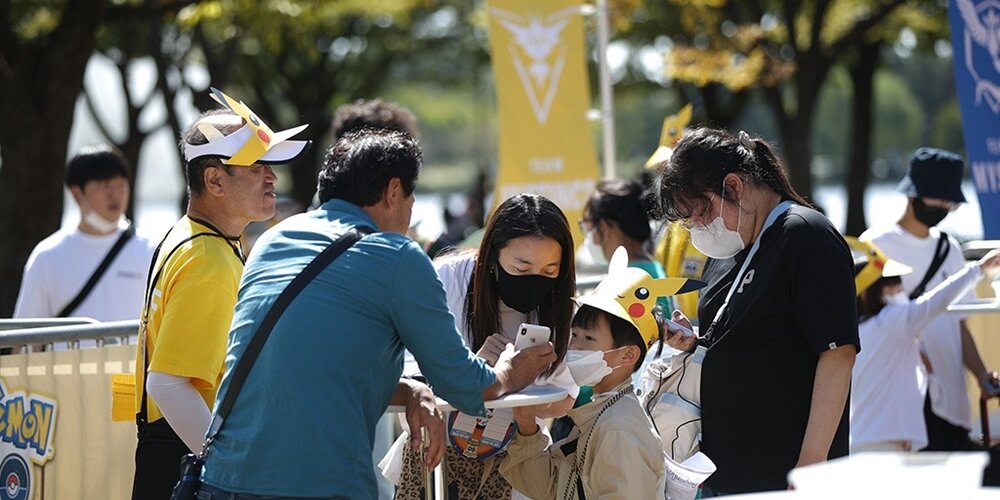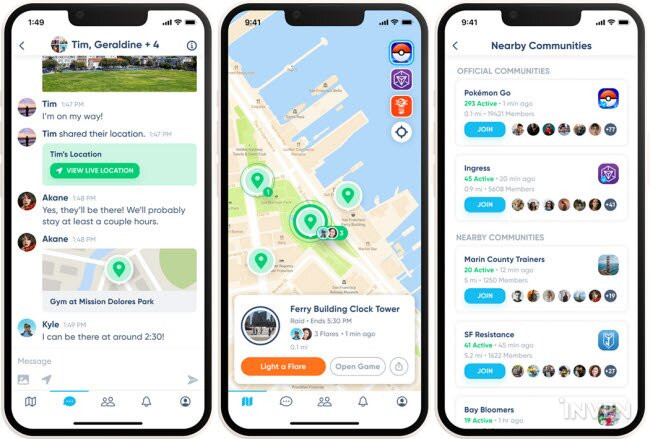
Niantic is a company that creates games that bridge the gap between virtual and physical reality. The variety of games they've created, and the fictional worlds they've created, have really taken many people "out of the game".
One of their most famous games, which is still played by millions of people, is Pokémon GO. In Korea, the game has been around since its release in 2017, and there are so many trainers, young and old, playing together.
However, Pokémon GO is definitely an outdoorsy game, and COVID-19, with its restrictions on outdoor activities, posed a real challenge to enjoying the game's content, especially raids, which require a lot of people to go out and join in. Niantic's solution was the Remote Raid System, which allows players to participate in raids from a distance.
Now, the pandemic is nearly over, and many trainers are once again heading out to join everyone. Ed Wu, VP of Pokémon GO, said that Niantic is preparing to adapt to this change once again. The goal is to get trainers back to interacting, meeting, and playing in the real world through Pokémon GO.
Inven spoke with VP Ed Wu, who has been with Pokémon GO since its inception, to find out what's next for the game, and what's happened so far.

Hello! Can you introduce yourself to our readers?
Hi, my name is Ed Wu, the VP of Pokémon GO. I’ve been with Niantic for over 10 years since before we were an actual company. I was part of Niantic while we were inside Google. When we left Google, I started up the Pokémon GO team as well as leading all the engineering and development behind Pokémon GO.
For several years I've been very excited to build this game for our many, many millions of
trainers all around the planet who have really enjoyed it. I’m very excited to be able to talk about our upcoming changes and in general, engage more and more with our community.
Now as the pandemic is almost over, how do you plan to bring trainers back outside when they're used to playing games indoors?
In a couple of days, we're going to announce that we're going to make some changes to the remote raid play mechanics inside Pokémon GO. We've made this change very carefully after examining a lot of data and a lot of factors about what to do about remote raids in the game, but the change is actually quite simple.
We're going to raise the price of remote rate passes, and we're going to place a cap on the number of remote raid passes that you can use each day. There are a couple of additional
game changes that we'll make that are smaller.
One, we will increase XL candy from real-life raids, and we will include remote raid passes as part of research breakthrough rewards. These last two pieces are mostly game-balancing changes.
We do plan to keep remote raid passes as part of Pokémon GO, but we really do need to address the effect that they're having on the long-term health of the game. On Thursday, Apr. 6, the changes will go live in the game.
It seems the changes to the remote raid passes are going to have a big impact.
I would like to discuss why it's important for us to make this change as a lot of people may have some concerns, but we believe this change is necessary for the long-term health of Pokémon GO to make sure that we can continue with the mission of getting people outside and exploring together.
The initial version of raids that we designed in 2017 was the first major feature that encouraged people to get together in the real world outside together, and it did not have any remote component. When we launched it, all of a sudden, hundreds of thousands, millions of people were riding together, meeting up in real life, to actually play the game together. It was amazing to see, but of course, in 2020, that was not possible.

The world changed a lot in 2020, and we had a responsibility, at that point, to temporarily adjust the game, so that's when we introduced remote raid passes, which allowed players to still go to raids, even when they could not be together.
Since then, the world has moved back outdoors, and remote raid passes are working in a way we never intended — they have now dominated the entire experience of playing the game. Remote raids have become a shortcut to playing the game, and so we're seeing this imbalance in the game economy. The current price of remote rate passes is the same price as normal raid passes, and it's distorting the whole game economy, making it unsustainable in the long term.
So in order to continue to operate the game, to be sustainable for many years to come, we've decided to raise the price of remote raid passes to encourage more real-life raiding. We are also capping the number of remote raid passes that can be used per day.
We know that this is a big change, and a lot of folks are going to have strong feelings about it. We're empathetic to it, but we really want this game to be here for decades to come, and we really believe that this is the right thing to do in order to make that happen.
As you would know, the remote raid passes brought back many players to the game. Do you think it’ll be alright?
As I said, we're not taking away remote raids completely — we're still allowing some of them at a different price point. So what do real-life raids require? They require working with people in your neighborhood, and in your community, organizing them, bringing them together, and then going to the same place at the same time. When you finish a raid in one location, they could be walking another 15, to 20 minutes to the next location together, interacting and exploring the world that whole time. That's what we truly value.
In addition to all of the fun gameplay is both the social interaction and exploration with others, as well as the incredibly fun raid that comes at the end. The problem with remote raid passes is that it's a shortcut. All that happens is that very fun part at the end without all of the incredible social interaction, walking, and exploration in between. Ultimately, we believe that the value of our game is just as much about the exploration and social interaction in the real world as the raids.
These two things are interlinked, and that's why people play our games as opposed to the many, many other games that they could play. It's because we are unique in delivering that value. If we shortcut that value, while it may seem like a convenience that people like in the short term, it creates an unsustainable game for us over the long-term health of Pokémon GO.

In Korea, Pokémon GO is very popular among teenage students. Students go out to catch Pokémon and naturally communicate with each other while they do, which is like what you explained about Niantic’s vision.
My own family is from Taiwan, which has many cultural aspects similar to Korea. It could be different, but we have such a diverse community, from students all the way to elderly people who play this game.
And one of the groups that often play this game is seniors. As in many Asian countries, the elderly come together in the morning to exercise together, doing various things like Tai Chi or taking a walk. A lot of those people actually use Pokémon GO as their morning exercise and social routine in these countries in Asia. They use this to have the benefit of not being isolated and not being alone, exploring together outside, and benefiting their bodies while doing a fun, engaging activity.
Pokémon GO has been around for 7 years already and still going strong. There are new trainers constantly flowing into the game. What is your secret to having new trainers keep coming in?
Actually, Korea is one of the best markets in which we've developed a number of Pokéstops over time. It really is among the top in the whole world, and that's because of
the incredible collaboration between the people who have loved the game from the very beginning and Niantic.
We have a program called Wayfarer, where we can work with our most enthusiastic players, and they can create Pokéstops through it in their neighborhoods. By doing so, they're making those neighborhoods more exciting and more enjoyable to play with for the next person who joins the game.
We are deeply indebted to our own community for their enthusiasm for making the game better day after day, week after week, month after month, and year after year. Those are the people who make it easier for people who are just discovering the game for the first time to find great places in their neighborhood, to explore, to get items from a Pokéstop that's near them so that they can get excited about the game.
This is the true strength of Pokémon GO. The community has invested so much of their own thoughts and consideration to help us map out the world and find the best places to play.


There have been several offline events like the Safari Zone. It came to Korea last year as well, which was a big success. Will we be able to experience more large-scale events this year as well?
Nothing to announce yet, but let me assure you last year in Korea was one of the best years for Pokémon GO in any country throughout its entire history. We really had an incredible, incredible enthusiasm for the game. It was incredibly gratifying to see that, and that enthusiastic response was part of why we held a live event in Korea last year.
I can say without reservation, that Korea is one of our most important markets in the world, and it's a place that, as the leadership of Niantic and Pokémon GO, we pay attention to daily to watch how folks are responding and how much and what we can do for them next.
While maintaining the accessibility of the game, you need to constantly provide something new for the excited trainers. How do you plan to strike that balance?
That's a great question because it's something I think about every day when I'm developing new features. We have to have this balance between those folks who've been playing with us every day since July 2016 and the person who picks up Pokémon GO for the first time. Everybody plays the game a little bit differently.
There are a couple of approaches to this. One is to make sure when we're building features, we're always thinking, ‘Will this feature actually be something that is appealing to everybody, all the way from the person who picks it up from the first time to the person who's been playing it for many years?’
We always make sure that it's balanced with great new features that everybody can enjoy. Things that we've released recently, like the Vivillon postcard feature where everybody can send and catch a special unique Pokémon via this idea of sending postcards from locations that you've spun Pokéstops at while traveling the world to let your friends and family see.
We are hoping to make sure that we span the set of features that are accessible to everyone while taking care of those folks who've been such a core part of our community for so long.

What is the next step for Pokémon GO?
As I mentioned several times, social gameplay is one of the most important ways that our community enjoys Pokémon GO. And social interaction is at the heart of the Campfire product we'll be rolling out in the next few months. This will be a great tool for trainers to work together, find each other, and play the game together. For raiding in particular, Campfire helps people to find each other to raid both locally and beyond. We’ve been testing and tuning that right now.
We also have a number of improvements to the raids themselves to make them easier to understand and easier to find, including seeing the time left in the current lobby as well as seeing the number of people in lobbies and gyms in the nearby view.
And again, can't announce the specifics, but we have new forms of raids with new kinds of bosses and mechanics. We believe our trainers are going to be very excited, we’ll be able to talk about it soon.
On top of that, one thing that's been very fulfilling for me working on the game in the past year is that it reminds me of the work that we did 5-7 years ago when we launched raids, when we launched gifting and trading, and when we launched buddies. These big features fundamentally change the game for the better and engage a whole new generation of trainers in Pokémon GO.

Sort by:
Comments :0








